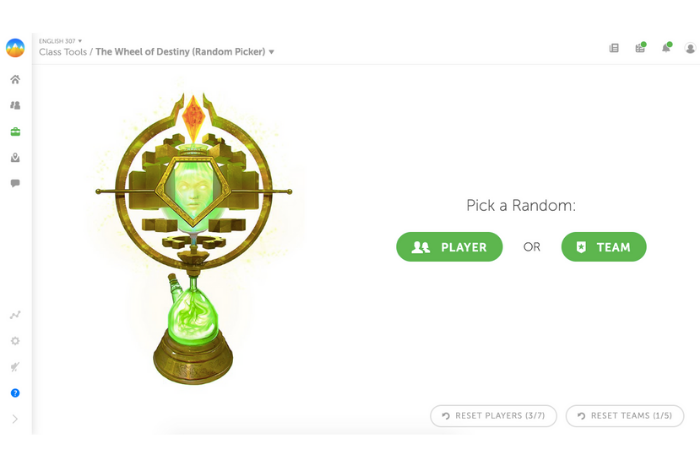In an ideal world, we’d get equal engagement from every student during every class. However, anyone that’s spent more than 10 minutes in a classroom knows this is far from the case. While every teacher has a few students they can rely on to raise their hand, there are also those that never attempt to answer a question or volunteer for anything. Sometimes, due to their introverted nature, they’ll remain silent if they know the answer.
The challenge is finding ways to involve those students in the lesson. Your students should know that you expect them to participate and that it’s not OK for them to try to blend in and allow only their classmates to speak up. By encouraging these students to participate, you’ll also acknowledge them as valid members of your class.
When it comes to selecting students for participation in class, randomization is one of the best techniques you can use.
Having a variety of ways to randomly select a student is incredibly useful for all students, not just the ones that rarely volunteer. Random selection puts the whole class on notice, reminding them that they could be chosen at any time. Students have greater incentive to pay close attention, as they can’t rely on one of their more extroverted or gifted peers answering every question. Better still, having a variety of fun ways to select a student gives them a share of ownership in the process. Knowing that they may have to participate at any time makes them active participants rather than passive ones.
With all this in mind, let’s take a look at different ways to randomly select a student.
7 fun random student selectors

1. Colored cards
A simple way to select a student at random is to pick a colored card with their name on it at random. You can also have the students make their own cards, which creates a short, fun task that gives them a little ownership in the idea of random selection. You can also have fun with how you pick a card, as you could have the students take one from your hand or out of a hat — like the sorting hat in Harry Potter!
The amount of things you can do with colored cards really opens up when you combine them with a color wheel, which we’ll explore a little later.

2. Playing cards
Similarly, you could use a pack of playing cards, writing a student’s name on each one. With this approach, you can make a big show of shuffling the deck, which the students will get a kick out of, especially if you know a few tricks or flourishes!
Playing cards also allow you to get creative and make use of the suits and/or numbers. You can use the suit, for instance, to decide which group has to answer a question in a team activity or could determine the type of question they have to answer. You could use the number to determine the question asked, if you prepare some questions beforehand and assign each one to a card. Alternatively, if you’re playing a game in which the students win points, the number could represent how many they’re awarded — provided they get the question right, of course!

3. Classcraft random picker
Technology can also help with selecting students at random. You can use one of Classcraft’s free tools called “The Wheel of Destiny.” This allows you to pick not only students but also teams. One feature that distinguishes this wheel from the more traditional tools is the fact that it keeps track of the previously selected students in class. This ensures that the same student isn’t called upon twice in the same sequence.

4. Color wheel
A colored spinner wheel is a versatile way of choosing students at random. The most straightforward approach is to create a wheel (having your class help out, naturally) with every student’s name featured on it. Then, when you want to choose a student, you spin the dial and call out the name of the student on which it lands. Not only does it choose a student at random, but it also injects a dose of fun into your classroom as your students wait for it to stop spinning.
That said, it’s actually far easier to use a digital color wheel, courtesy of websites and mobile apps, of which there are many. With those, all you have to do is load up the wheel, enter your students’ names, and click away. Better yet, most allow you to save the names you entered, so you only have to enter them once.
However, a color wheel is good for more than just choosing students and offers tons of randomization opportunities. You could, for instance, have two wheels: one for selecting a student and another for determining the kind of question you’ll ask them. You can then create a series of categories denoted by color and write questions on different colored cards. Then, when the wheel lands on that color, the student or team gets asked a question from that category

5. Dice
If you haven’t managed to get around to creating your color wheels, a simple alternative is to use a couple of dice. Now, if you have more than six students, you’ll have to be a little creative in who has to answer the question. One solution is to split the class into segments, with ‘one’ responding to a particular table or group of students, ‘two’ to another, and so on. You could then roll again to see which member of that selected group has to answer the question.
You can also have some fun with it, giving one or more of the numbers a special function. For example. once you’ve determined the group by an initial throw, rolling a three would allow them to skip a turn so they don’t have to answer a question. There are plenty of things you can do to add a little excitement.

6. Let the students choose
If you’re engaged in a task that everyone in the class has to do, one at a time, you could have the student pick the person that follows them. Granted, this isn’t strictly random, and you’ll have to do a little stewarding, but it means that you’re not responsible for choosing the next student or picking eager volunteers, so it does the job! Besides, in my experience, it’s fun and gives the students a tiny bit of responsibility — which they tend to absolutely relish.

7. Colored sticks (pencils, or chalk)
As well as looking pretty neat, colored sticks let you choose students according to their different abilities or academic needs, allowing you to better manage a diverse class. With this approach, you assign students a color, which corresponds to their level of ability or academic needs. You’d then place the sticks in a cup and ask a question based on the color of the stick you draw.
This technique requires organization and you’ll have to have as many variations of a question as you have colors. Let’s say, for example, that you go with a system of red, orange and green, with red for the most gifted students and green for those currently performing at a below-grade level. You’d then need three variations of each question you intend to ask during the lesson.
Best of all, you can get the students to make their own sticks, which, like making their own colored name cards, is a fun little task that makes them feel they’re part of the process.
Get more out of your students in each lesson
There are plenty of creative and fun ways to select a student at random, especially with a little prep beforehand. By making good use of these strategies, you’ll consistently be able to get more of your class in each lesson. Not only will you keep your students on their toes, but you’ll also give the more introverted members of your class practice in speaking up. Over time, there’s a good chance that a number of them will gain confidence and volunteer more frequently — which is one of the greatest gifts you could possibly give a young student.
Photo: Google Edu
Classroom Management


